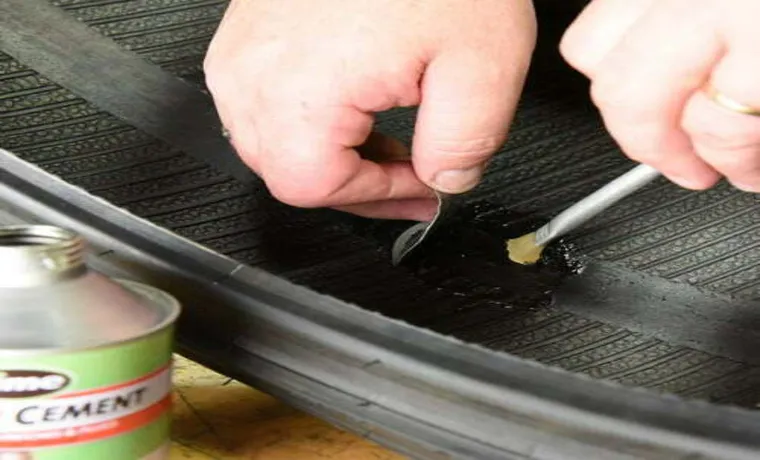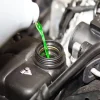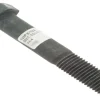Rubber Cement may not be the first thing that comes to mind when you think of tire plug kits, but it’s a vital component for repairing punctures. This adhesive liquid forms a strong bond between the tire and the plug, sealing the damaged area and preventing further air leaks. Without rubber cement, your tire plug kit is incomplete, and the repair may be ineffective.
In this blog, we’ll cover everything you need to know about using rubber cement in tire plug kits, from why it’s necessary to how to apply it correctly. By the end of this post, you will be equipped with the knowledge to confidently tackle any punctured tire.
Table of Contents
Overview of Tire Plug Kits
If you’ve ever had a flat tire, you know the importance of having a tire plug kit on hand. But have you ever wondered what the rubber cement is for? The rubber cement is an essential component in the tire plug kit that helps the repair plug adhere to the puncture site. This chemical adhesive is made of vulcanizing agents, solvents, and accelerators that work together to create a strong bond between the tire and the plug.
When properly applied, the rubber cement fills in any gaps and creates airtight seals, ensuring your repaired tire will hold up to pressure and road conditions. Without the rubber cement, there is a higher risk of the repair plug not sticking, and the puncture may not be properly sealed, leading to further damage or flat tires. So, the next time you use your tire plug kit, make sure you apply an ample amount of rubber cement for a durable and long-lasting repair.
What are tire plug kits?
Tire plug kits are a handy tool for fixing tire punctures quickly and easily. They are compact and can be carried in the trunk of your car, making them a convenient option for emergencies. The kit contains a few essential items, such as a reamer to widen the hole and a plug to fill it.
Using a tire plug kit is straightforward, even for those who are not mechanically inclined. Simply locate the puncture, remove any debris from the area, insert the reaming tool, and then push in the plug until the hole is fully sealed. This can be done in a matter of minutes, allowing you to get back on the road and continue your journey.
Overall, tire plug kits are an affordable and reliable solution for fixing unexpected tire damages and avoiding the cost of a costly tire replacement.

Why are they used?
Tire plug kits are essential tools for any driver who wants to be prepared for unexpected punctures. These kits usually include a set of tools such as a reamer and insertion tool, as well as plugs made from materials like rubber or synthetic fibers. They are used to repair punctures and leaks in car tires quickly and easily, without the need to replace the entire tire.
These kits are especially useful for those who frequently drive on rough terrain or in areas with unpredictable weather conditions that can increase the likelihood of getting a flat tire. Overall, investing in a reliable tire plug kit is a smart decision for any driver who wants to ensure their safety and avoid unnecessary expenses in the long run.
Components of a Tire Plug Kit
When it comes to fixing a punctured tire, having a tire plug kit on hand is essential. The kit usually includes several components, including tire plugs, a needle, and rubber cement. The rubber cement is a crucial component of the kit because it helps the plug adhere to the tire and creates a seal that prevents air from escaping.
Without it, the plug may not stick to the tire properly and could loosen over time. The rubber cement acts as an adhesive, making sure that the plug stays in place and prevents further damage to the tire. So, the next time you find yourself dealing with a punctured tire, make sure that you have all the necessary components of a tire plug kit on hand, including the all-important rubber cement.
What is included in a tire plug kit?
A tire plug kit is one of those essential items that every driver should have in their vehicle. But what exactly is included in a typical tire plug kit? The components may vary slightly from brand to brand but generally, a tire plug kit contains a T-handle reaming tool, a needle-shaped insert tool, a container of rubber cement, and several plugs made from a durable, rubber material. The reaming tool and insert tool work together to puncture and seal the hole in the tire while the rubber cement helps hold everything together.
The plugs are then inserted into the punctured area and left to dry. With these components, you can easily repair most punctures on the go and save yourself the hassle of changing a flat tire. It’s an affordable and efficient solution for emergency tire repair.
Plus, it saves you time and money by minimizing the need for professional tire repairs or replacements. So, make sure you have a tire plug kit in your car and be ready for any unexpected punctures!
What is rubber cement used for?
Rubber cement is a versatile adhesive that can be used in a variety of applications. One common use is in tire repair, specifically in conjunction with a tire plug kit. A tire plug kit typically consists of a rubber plug and a blunt tool that is used to puncture the tire.
Once the puncture has been made, the tool is used to insert the plug into the hole. To ensure a secure fit, rubber cement is applied to the plug before it is inserted. The rubber cement helps to create a seal around the plug, preventing air from escaping the tire.
The use of rubber cement in tire repair is a testament to the adhesive’s strength and durability. When used correctly, a tire plug kit can help extend the life of a tire and save drivers the expense of purchasing a new one. So, if you ever find yourself with a punctured tire, remember that rubber cement, along with a tire plug kit, can be a quick and easy solution to your problem!
Uses of Rubber Cement in Tire Plug Kits
When you encounter a flat tire, using a tire plug kit can be a lifesaver. One component found in these kits is rubber cement, which is used to help seal the punctured area of the tire. The rubber cement is applied to the hole before inserting the plug to ensure that it adheres to the tire surface.
This helps create an airtight seal that prevents air from leaking out of the tire. Additionally, the rubber cement can also help lubricate the plug, making it easier to insert into the hole. It’s important to note that the rubber cement in tire plug kits should be used sparingly as too much can actually degrade the tire’s rubber over time, causing further damage.
So, the next time you have a flat tire, remember that the rubber cement in your tire plug kit is essential for repairing it quickly and efficiently.
How does rubber cement work in a tire plug kit?
Rubber cement is a crucial component of tire plug kits. This adhesive material is used in conjunction with a rubber plug to seal punctured tires effectively. Rubber cement works by bonding the rubber plug to the inside of the tire’s punctured area.
Once the cement sets, it creates a tight seal that prevents air from leaking out. This adhesive is known for its fast-drying capabilities, allowing for quick tire repair. Additionally, rubber cement is specially formulated to withstand the pressures and high temperatures inside tires, ensuring long-lasting effectiveness.
The next time you experience a flat tire, consider using a tire plug kit with high-quality rubber cement to get back on the road safely and quickly.
What are the benefits of using rubber cement in tire plug kits?
Rubber cement is an essential component of tire plug kits, and using it can result in a lot of benefits. Firstly, it helps to seal any small punctures in the tire effectively. By using rubber cement, the tire plug can adhere to the surface of the tire, providing a tight seal that is resistant to air leakage.
Additionally, rubber cement helps to create a strong bond between the plug and the tire, ensuring that the repair lasts longer. Another benefit of using rubber cement is that it can prevent further damage to the tire. By sealing the puncture with the plug, the tire is protected from small stones and other debris, which may cause further damage.
Using rubber cement is also straightforward, and it doesn’t take long to complete the repair. Moreover, rubber cement is resistant to water, making it an ideal material to use in wet conditions. In conclusion, using rubber cement in tire plug kits provides a long-lasting, effective, and hassle-free solution for repairing punctured tires.
Conclusion
Congratulations on making it to the end of this informational piece! After much consideration and contemplation, we can confidently say that rubber cement is the superhero of the tire plug kit. Like Superman, it swoops in to save the day by forming a strong bond between the plug and the tire, ensuring a seamless and enduring repair. Without it, the plug would be like Batman without Robin – lost and incomplete.
So, next time you’re using a tire plug kit, remember to give a little credit to the humble rubber cement for its crucial role in keeping you on the road!”
FAQs
Why is rubber cement included in a tire plug kit?
Rubber cement is included in a tire plug kit to help the plug adhere firmly to the inside of the tire and prevent air from escaping through the puncture.
Can I use any type of rubber cement for tire plug repairs?
No, you should only use the rubber cement provided in the tire plug kit as it is specially formulated for this type of repair.
How much rubber cement should I use when repairing a tire puncture?
Use a small amount of rubber cement to coat the tip of the plug and the inside of the puncture, following the instructions provided in the kit.
Can I skip using rubber cement when repairing a tire puncture?
It is not recommended to skip using rubber cement when repairing a tire puncture as it may compromise the effectiveness of the repair.
How long does it take for the rubber cement in a tire plug to dry?
The drying time for the rubber cement in a tire plug kit varies depending on the brand and type of cement used. Generally, it takes anywhere from 5 to 20 minutes to dry.
Can I use a tire plug kit to repair a sidewall puncture?
No, tire plug kits are only suitable for repairing punctures in the tread area of the tire. Sidewall punctures require a different type of repair.
Is it safe to drive on a tire that has been repaired with a plug and rubber cement?
Yes, as long as the repair has been done correctly and the tire has been thoroughly inspected for any signs of damage or wear. However, it is always recommended to drive cautiously and have the tire inspected by a professional as soon as possible after a repair.



